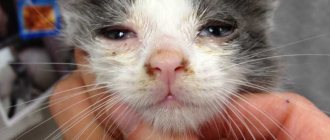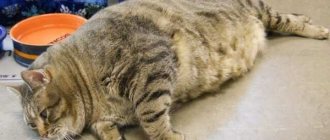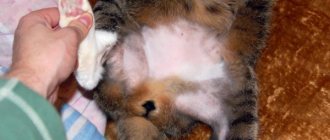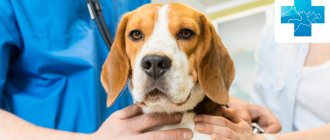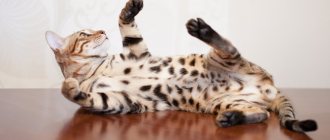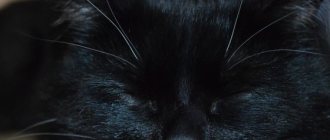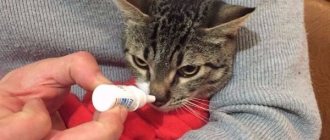Inflammation of the pancreas—pancreatitis—occurs quite rarely in cats. But if you do not give the animal due attention and do not start treatment, the disease will progress, which will lead to serious health problems and may cause the death of your pet.
One attack will not lead to tragic consequences, but regular repetition will cause serious dysfunction of the organ and will give rise to other diseases of the digestive system. They will negatively affect the well-being and longevity of the pet.
Causes
The cause of the disease may lie in heredity or hormonal fluctuations, as well as many other factors.
The main ones are:
- hormonal imbalance and, as a result, an increase in free fats in the body;
- cat's stress state;
- bearing and giving birth to kittens;
- genetically determined organ pathologies;
- metabolic disorders;
- change of feed;
- frequent consumption of fatty foods;
- high content of foods enriched with calcium;
- intoxication;
- infection by fungi or worms;
- consequences of surgical procedures;
- abdominal injury;
- inflammatory processes in the liver, stomach or gall bladder.
The list goes on for a long time. Veterinarians note that some cat breeds have a genetic predisposition to the disease. These are representatives of the Thai, Siamese or Balinese breed.
It has been proven that females are more likely to suffer from inflammation than males. Most likely, this is due to hormonal changes.
Elderly representatives often become victims of pathology due to disruptions in the normal functioning of body systems.
Complications and consequences
High mortality in the acute form is associated with early complications arising from the inflammatory process. It leads to thrombosis, internal bleeding, liver and respiratory failure.
With a prolonged course of the disease, the likelihood of developing oncology and the appearance of fistulas increases. The body's defenses gradually decline, so it becomes vulnerable to pathogenic microorganisms. In the event of a secondary infection, not only the pancreas suffers, but also the nearby intestines and other neighboring tissues. This leads to purulent abscesses, fraught with the appearance of sepsis. With this outcome, the animal may die from blood poisoning.
Another dangerous complication is pancreatic necrosis. This pathology is accompanied by the death of tissue of the affected organ and loss of its functionality. Enzymes and breakdown products entering the bloodstream aggravate intoxication. Not only the immediate organs are in danger, but also the heart and brain. In 90% of cases, pancreatic necrosis is incurable.
With late treatment, the acute form develops into a chronic form. Like pancreatic necrosis, it is incurable. Treatment is based on symptomatic therapy, lifelong diet and regular prevention.
Risk factors
Often, veterinarians cannot determine the true cause of the disease, considering it idiopathic. In most cases, pancreatitis is the result of an unsuccessful operation or injury to the peritoneal area.
Cats that have had toxoplasmosis, infectious peritonitis or immunodeficiency virus are also at risk.
Some medications that cause poisoning in pets can cause the development of dangerous pathologies. For example, the prescription of aspirin or organophosphate poisoning.
Diagnosis of the disease
Diagnosis of pathology includes modern research techniques, in particular, examination using ultrasound. Ultrasound helps to detect swelling and changes in the structure of the affected organ, identify inflammation, and also determine the presence of pathologies in other organs of the gastrointestinal tract. In addition, the animal is prescribed a general and biochemical blood test. In some cases, the pet undergoes diagnostic laparoscopy and a biopsy of the problem organ.
The most accurate way to diagnose pancreatitis is ultrasound
Symptoms
The disease is characterized by a latent course, symptoms are usually not expressed. The destructive effect in the body occurs rather slowly and in the first stages is manifested only by apathy and weakness of the animal.
Particular attention should be paid if the cat has become drowsy and less active.
In the future, the following symptoms may appear:
- profuse and regular vomiting;
- loose stools with a sour odor;
- accelerated heartbeat;
- shallow breathing, often rapid;
- increased body temperature;
- yellowness of the mucous membranes and skin;
- pain syndrome as a result of palpation of the abdomen.
Symptoms do not appear immediately. As a rule, this happens gradually and depends on the stage of the disease.
Main symptoms
Signs of pancreatitis can be pronounced during an acute attack and blurred during the chronic course of the disease. An acute condition is characterized by a sudden onset with the following manifestations:
- Very strong, unbearable pain, from which the animal can fall into a state of shock.
- Vomiting, which develops in paroxysms, can be uncontrollable even when the cat’s stomach is empty.
- Lethargic state, absence of any reactions. The animal tries to hide in the far corner and avoids people.
- Touching the stomach causes severe pain, and the cat may even bite or scratch the owner.
- Diarrhea or complete absence of bowel movements.
- Yellowing of the mucous membranes due to bile spillage.
- Severe dehydration, due to which the animal's eyes become sunken and the folded skin does not straighten.
In the chronic course of inflammation, the cat periodically begins to vomit, digestion is disrupted, problems with excretion arise, mainly diarrhea is observed, there is no appetite or the animal eats very little.
The cat is lethargic and looks unkempt due to matted and dull, brittle fur.
Diagnostics
Before prescribing quality treatment, the doctor conducts an extensive examination of the cat. Research by scientists has shown that the level of liver enzymes amylase and lipase do not have a high diagnostic value. They are measured in the blood and taken into account only in the case of a comprehensive examination and other tests.
Some indicators may indirectly indicate concomitant diseases of the body. For example, azotemia can be observed in pets with dehydration, and hyperglycemia is often an indicator of stress, but sometimes indicates diabetes mellitus.
A test for thrips-like immunoreactivity has been developed for cats. But, unfortunately, it also does not give high results in diagnosing pancreatitis in cats.
Subsequently, two more tests were invented, which differ from the first in technology. They are intended for the determination of pancreatic lipase. They are effective in almost all cases of pancreatitis, except for the mild form.
Subsequently, an enzyme-linked immunosorbent assay was developed, which is of high importance in diagnosing the disease. However, the most reliable results are provided by visualization, in particular ultrasound examination of the abdominal cavity.
Modern computed tomography methods are currently less informative due to the difficulties of visualizing the pancreas in pets.
In the future, with the development of equipment, this situation may change.
Biopsy and histopathology will help to distinguish the chronic process of the disease from the acute form. These are the most reliable ways to diagnose pancreatitis in cats. However, not everyone can undergo these procedures for a variety of reasons.
Causes of pathology
The risk group includes oriental breeds: Thais, Balinese, Orientals, Siamese. Also, the likelihood of developing the disease increases after reaching 8 years of age and during pregnancy.
The main causes of pancreatitis in cats include:
- Oncology, accompanied by an increase in calcium concentration in the blood plasma.
- Abdominal trauma, including failed sterilization or other abdominal surgery.
- Incorrect feeding. For mustachioed pets, a sudden transition to a new type of food, any food from the human table and fatty meats is dangerous. In addition to quality, it is important to consider the quantity of food. The disease is often diagnosed in animals that are overweight or underweight.
- Poisoning by poisons, chemicals, medications, spoiled food, household chemicals and other dangerous substances.
- Incorrect organ structure or congenital developmental pathologies.
- Infections (calcivirosis) and helminthiasis (infection with liver worms).
- Long-term antibiotic therapy or long-term treatment with sulfonamides, diuretics and hormones.
- Diseases of the gastrointestinal tract (cholecystitis, gastritis, cirrhosis).
- Stress. Prolonged exposure to a stress factor is detrimental not only to the psyche, but also to internal organs.
- Hormonal disorders, including thyroid pathologies, hypercortisolism syndrome and diabetes mellitus.
If there is no obvious cause, the disease is called idiopathic. In this case, eliminating the provoking factor turns out to be impossible.
Treatment of chronic and acute pancreatitis in cats directly depends on the cause of its occurrence. Only a veterinarian can make an accurate diagnosis, so do not try to find the source of the problem yourself. The longer a pet is left without help, the less likely it is to be saved.
Drug treatment
Drug therapy for cats with pancreatitis includes several measures that are aimed at improving the health of the body, as well as reducing the symptoms of the pathology. The doctor prescribes appropriate medications only after a thorough examination and an accurate diagnosis.
Restoring water-salt balance
Symptoms of pancreatitis are often associated with dehydration. This is why the first thing a doctor should do is prescribe any saline solution to combat this condition.
Warm, it is administered intravenously to the cat, very slowly. The volumes of the droppers are usually large, so the process takes a fairly long period. Often, to make the drip more serious, antioxidants and vitamins are added to its composition.
Anesthesia
In the acute form of the pathology, the cat is capable of experiencing severe pain, which, in turn, triggers a number of undesirable reactions in the body. This often contributes to the development of complications.
Veterinarians use the prescription of opioid painkillers because other types of medications cause stomach acidity.
There are frequent cases of installation of a catheter in the spinal canal for spinal anesthesia, carried out continuously. Antispasmodics are absolutely powerless in the acute form of the disease.
Reduced stomach acidity
Signs of progression of pancreatitis in cats often include stomach and intestinal ulcers. That is why it is necessary to be treated not only with specific medications, but also to reduce the acidity of the gastrointestinal tract with available drugs. You can use Omeprazole, Phosphalugel, Ultop, Ranitidine and other well-known drugs.
Antiemetic therapy
Vomiting during the development of the disease contributes to the exhaustion of the animal and the inflammatory process in the esophagus, also causing dehydration. This symptom must be controlled with medication.
Sereniya is the drug that is most preferred for treating cats. Cerucal and Zofran are also used, but their use is contraindicated if a foreign object enters the pet’s gastrointestinal tract.
Other drugs
In addition to enzymes, the pancreas produces a hormone - insulin. It regulates blood glucose levels. If the values increase, insulin replacement therapy is used or synthetic drugs are used that can reduce the values.
If the animal shows signs of infection or has undergone surgery, antibiotics may be necessary. Gastrointestinal ulcers in an animal are fraught with a decrease in the level of protein in the blood, in particular albumin. To maintain the cat's health, it is administered intravenously.
It is rightly noted that there is no specific therapy for pancreatitis. The main task of veterinarians in the event of a cat illness is to prevent the development of complications and reduce the manifestation of symptoms of the pathology. Thus, they allow the body to recover from the disease on its own.
Diet
To alleviate the condition of a furry pet and to reduce vomiting, a starvation diet is usually prescribed. In this case, the period without food should not exceed 1-2 days. Otherwise, complications in the form of liver lipidosis are possible.
The basic principle of feeding a sick cat is to provide low-fat, easily digestible food often, but in small portions. It is best to use industrial wet food for this.
Home cooking of natural food is also allowed, but in this case you will have to stick to the diet for quite a long period of time.
How to treat pancreatitis in cats
Treatments for pancreatitis in cats depend on the symptoms and cause. If the form is mild, the pet is treated at home, and if there is a threat to life, it is strictly in a hospital.
Medication
Unlike the liver, the pancreas is not able to repair its cells. There is no specific therapy for pathologies of this organ, so treatment is based on eliminating possible causes and relieving symptoms. The functionality of the gland will never be the same, but with timely help it will be enough to maintain the animal’s life.
First of all, the mustachioed patient is restored to the water-salt balance, disturbed due to dehydration. He is given subcutaneous or intravenous drips with infusion solutions (Regidron, Acesol, saline solution with glucose, Dextran-70, Ringer's solution). If the glucose value is elevated, it is lowered with the help of Reamberin or Caninsulin. To boost immunity, vitamin C, iron and antioxidants (Emicidin, Mexidol) are added to the solutions.
Debilitating attacks of vomiting that prevent independent consumption of food are suppressed with Zofran, Cerucal or Serenya. All medications are agreed with the doctor. Self-administration of medications is fraught with complications. The same Cerucal, which stimulates gastrointestinal motility, can cause internal bleeding if a foreign body is in the intestine. Until vomiting is eliminated, animals are fed through a special tube, stimulating appetite with Mirtazapine.
In especially severe cases, blood or plasma transfusions are used. This procedure is available in a limited number of veterinary clinics, so a sick cat may be sent to hospital treatment far from home.
To relieve acute pain, it is recommended to take opioid analgesics (Fentanyl, Tramadol, Butorphanol). Unlike classic painkillers, these medications do not increase stomach acidity. The problem is that most veterinary clinics do not have opioids, so the pain is relieved with Baralgin, Papaverine and Spazgan. These drugs are less effective, and if there is an ulcer, they are even dangerous.
To protect ulcerated mucous membranes, antacids and gastroprotectors are used: Famotidine, Phosphalugel, Omeprazole, Ranitidine. Intravenous administration of albumin is also recommended for patients with stomach or intestinal ulcers. This is necessary to prevent pulmonary edema.
Digestive function is normalized by taking pancreatic enzymes (Pancreatin, Creon). If a secondary bacterial infection is detected, antibiotic therapy is prescribed using broad-spectrum drugs: Sinulox, Cefazolin. To suppress the increased production of pancreatic lipase, its inhibitors (Gordox, Kontrikal) are prescribed.
Surgically
The operation is performed when there is blockage of the bile duct, the presence of abscesses, cysts or tissue necrosis, as well as the lack of effect of drug treatment or the impossibility of making a diagnosis in any other way. Surgical intervention in the abdominal cavity is performed under general anesthesia.
During the operation, the peritoneum is incised along the linea alba and the resulting incision is secured with special dilators. To identify the cause of the pathology, the surgeon carefully examines and palpates the internal organs. He removes the accumulated liquid with a special syringe. Dead tissue and cysts are carefully removed with a scalpel. To relieve pain, a novocaine blockade is placed. If generalized peritonitis is detected, the wound is not sutured, since weekly rinsing with saline solution is required to eliminate it. This procedure is carried out under sedation, tightening the incision until the next time.
Regardless of the treatment method, all animals are given a gentle diet. It relieves the load on the affected organ, helping to normalize its functioning. For patients with a chronic diagnosis, therapeutic nutrition continues throughout life.
Diet
In the absence of severe exhaustion, the mustachioed patient is prescribed a starvation diet. This eliminates the need for digestion and gives time to restore the functionality of the diseased organ. The duration of the fasting diet is selected individually; in kittens it is always less than in adult pets.
At the end of the starvation diet, the animal is fed according to the following rules:
- The number of feedings increases in favor of reducing portions. Fractional meals are the basis of any gentle nutrition.
- All food is served in liquid or pureed form. The absence of coarse fibers reduces the load on the gastrointestinal tract.
- The temperature of the food should not be lower or higher than room temperature. Digesting cold food requires more effort and time, and food that is too hot can burn your mucous membranes. This is especially dangerous if you have an ulcer.
When feeding natural food, use lean meats (rabbit, chicken, turkey) and watery cereals (rice, oatmeal, buckwheat). Animal proteins can also be obtained from steamed protein omelettes and fermented milk products with low fat content, but rich in calcium. For vegetables, it is better to choose pureed carrots or zucchini.
During treatment, strong meat broths and fruits and vegetables that have not undergone heat treatment are prohibited. Fatty fish and meats, as well as legumes and milk are no less dangerous, but they are not recommended for consumption even by healthy animals.
In pet stores and veterinary clinics you can purchase medicinal food for cats with pancreatitis marked i/d. Most well-known brands have this line, so it is preferable to choose the one that you already feed your pet.
At first, instead of granules, it is better to give pouches or canned food with soft pieces - they are easier to digest. Each package contains convenient instructions to help you determine the required amount. If your pet is exhausted or obese, it is better to discuss the daily serving size with your veterinarian.
What to feed your cat
It is important to observe the temperature regime for serving food. A cat weakened by the disease needs to eat warm food several times a day. In this case, portions of the product should be small, meals should be fractional.
If industrial feeds are used for feeding, you need to carefully study their composition. The use of cabbage or corn in the preparation of the product can negatively affect the condition of the pet.
In addition, the cat should be fed separately. To do this, give different foods at each meal.
At first, only easily digestible food is used; low-fat varieties of fish and meat are suitable, from which broths are prepared.
Be sure to exclude sausages and fried foods, as well as fresh vegetables and fruits. The main condition is to drink enough clean drinking water.
Also read the article about the proper diet of cats and kittens.
Diagnostics in a veterinary clinic
In addition to external examination and questioning of owners, the veterinarian will send the cat for the following examinations and tests:
- Ultrasound of the abdominal cavity. It will reveal the condition of the entire digestive system and detect enlargement and inflammation of the pancreas, since in a healthy animal it is almost invisible during such an examination due to its position.
- X-ray examination. It will eliminate the presence of a foreign body in the intestine, fecal blockage, or obstruction.
- Blood analysis. A test is taken for general indicators and biochemistry, since it is necessary to obtain the maximum amount of data about the cat’s health status.
- Diagnostic laparotomy. This method is used if other methods fail to obtain conclusions or the treatment undertaken is ineffective. With the help of surgery, it is possible to exclude the presence of a benign or malignant tumor, cyst, abscess, and also carry out a novocaine blockade. The use of this remedy helps to cope with uncontrollable vomiting.
If the furry pet’s condition is serious, it will be left in the clinic to recover from an acute attack.
Mr. Cat warns: pancreatitis and relapses
A cat that has had pancreatitis remains at risk of recurrence of the disease throughout its life. Any, even minor, negative factor can cause a recurrence of the pet’s pathological condition.
To eliminate the risk of developing the disease, they adhere to strict rules in the animal’s diet. Avoid fried foods and ensure that calcium levels in industrial feeds are not exceeded.
Do not allow the animal to overeat or starve, provide it with constant access to clean drinking water.
It is also necessary to ensure sanitary treatment of the premises where the cat lives. Regular medical examination and deworming are also considered a prerequisite for the health of a pet.
Treatment of pancreatitis
First of all, when pancreatitis is diagnosed, the animal is prescribed therapeutic fasting for at least a day. A fasting diet for up to three days will reduce the enzymatic activity of the pancreas. Omeprazole may be prescribed for the same purposes. If the symptoms are not severe, the pet is prescribed the following medications:
- to eliminate pain and spasms - No-shpa, Papaverine, etc.;
- antiemetics - Cerucal, Chlorpromazine;
- cardiac - Cardiamine, Camphor;
- to combat dehydration - physiological and glucose solution.
Glucose solution is contraindicated if the animal has diabetes mellitus.
Without eliminating the cause that led to the development of the pathology, it will be impossible to cure pancreatitis. The pet may be prescribed medications to fight infection and anthelmintics. To reduce the production of enzymes that have a destructive effect on the organ, Atropine is prescribed; to eliminate swelling and inflammation, hormones and Ribonuclease are prescribed.
If you do not provide medical assistance to the animal in a timely manner, toxins from the pancreas will enter the bloodstream, resulting in infection of the entire body.
In severe cases, surgical intervention is required - removal of part of the organ affected by necrosis, cysts and purulent fillings. After surgical manipulations, the organ cavity is washed and irrigated with antibiotics.
Nutrition for pancreatitis
Proper nutrition is important in the treatment of pancreatitis in cats. The animal needs to be fed often - 5-6 times a day, but in small portions. At first, the diet should include well-cooked, liquid porridge. Low-fat fermented milk products, carrots and zucchini puree are good for your pet. Your pet should have filtered water freely available.
If your pet is accustomed to ready-made food, its diet should include special premium medicinal food - Royal Canin Gastro Intestinal Moderate Calorie, Eukanuba Intestinal, Hill's i/d. As a rule, a specialist recommends using these ready-made products for life.
Dietary foods Royal Canin Gastro Intestinal Moderate Calorie, Eukanuba Intestinal, Hill's i/d consist of easily digestible components, prebiotics
Products prohibited for pancreatitis include:
- fatty meat and fish;
- eggs;
- raw plant foods;
- fatty fermented milk products.
Not only sick, but also healthy animals are prohibited from including any smoked, fried and canned foods, salty foods and spices, milk, sweets and baked goods in their diet.
The composition of finished products for cats, the so-called budget category, is very questionable. Such food can be harmful to the health of any animal. Experts do not recommend food brands such as Kitekat, Darling, Whiskas, Frieskies, Felix.
Chronic pancreatitis
The chronic form of the disease can develop for years without significant symptoms. The owner is usually unaware of the health problems of the pet. But at the same time, the pet will only get worse. This is where the danger of chronic disease lies.
In this case, only careful monitoring of the pet’s condition will help. The disease is usually indicated by dull fur, yellow stools, and stomach noises. Your pet's eyelids too often end up drooping as they experience constant drowsiness and lethargy.
The prognosis for chronic pancreatitis is completely bleak, so treatment begins as early as possible.
Feeding cats with pancreatitis
What to feed a cat with pancreatitis? Feeding a cat with pancreatitis should be fractional. Don't strain your pancreas. Better often, but in small portions. In addition, this will not lead to a large release of glucose into the blood; after all, the inflamed pancreas secretes less insulin. Here are some simple rules:
- Food (if it is natural) needs to be slightly heated (slightly above room temperature, so as not to irritate the digestive tract again). Do not feed it too hot or just taken out of the refrigerator.
- Do not “overload” the animal’s menu. You don't need to give a bunch of everything a day. It’s better to eat one product at a time, gradually introducing more and more new types of food. At first, it is better to give low-fat broths and easily digestible porridges (oatmeal, rice).
- There should be a lot of water. It needs to be filtered in advance, but it should be warm (room temperature).
- If the animal gets worse, switch to light food again, and immediately call or visit a veterinarian!
There is a list of prohibited foods for a cat with pancreatitis. It is strictly forbidden to give them, even if the pet feels better. It is worth understanding that for a long time after recovery (or visible improvement) the animal is at risk. Therefore, you should not risk feeding something that can bring back the disease.
Prohibited Products
List of prohibited foods for a cat with pancreatitis:
- Cabbage. It is not recommended to be given to healthy animals either.
- Corn. If you feed dry food, carefully study the composition. Manufacturers often save money by adding corn and its “derivatives” to feed.
- Boiled eggs. Protein is absorbed much better than yolk, but with pancreatitis you should not give protein either, the food is too heavy.
- Raw vegetables, fruits. The gastrointestinal tract is not yet ready to digest fiber.
- Do not give whole grain porridge to a sick cat.
- Refrain from feeding fatty foods (meat, dairy, fish).
Forget about “human treats”. No sweets (especially chocolate). Sausages and sausages are not at all suitable for feeding a pet! You can’t even add simple table salt to a cat, and what can we say about sausages and sausages? How much “useful” stuff is there? The digestive tract will not cope, its irritation will only become even more pronounced.
- Roast? This is contraindicated even for feeding a healthy animal!
- Avoid fermented milk products! And save anything that has a sour taste until “better” times.
Prevention
Veterinarians advise following a number of preventive measures that will help prevent the development of a dangerous disease.
These include:
- regular administration of appropriate vaccines and removal of helminths;
- use of fresh and high-quality feed, for example, holistic;
- not allowing food from your own table into your diet;
- reducing the amount of calcium-containing products;
- tracking your pet's weight;
- no contact of the pet with household poisons and poisonous plants.
When undergoing therapy prescribed by veterinarians, compliance with the dosages specified in the prescription and taking the medication according to a pre-agreed schedule are mandatory. Early diagnosis and proper treatment are considered the key to the animal’s recovery.
Symptoms of pathology
Only a veterinarian can accurately diagnose and prescribe appropriate therapy. Unlike a person or a dog, who cannot remain silent in the presence of severe pain, a cat steadfastly endures the unpleasant moments of the disease, preferring to sleep more. If the following symptoms characteristic of an acute form of pathology appear, the owner should be concerned:
- almost incessant vomiting and stool disorders - diarrhea, in which the feces have a sour smell or constipation;
- dehydration - dry skin, dull fur;
- lethargy and lack of interest in games and communication;
- pain syndrome;
- disturbances in the functioning of the respiratory and cardiovascular systems;
- temperature increase;
- yellowness of the skin.
In each specific case, you can observe either all at once, or only some of the listed symptoms.
The acute form of the pathology poses the greatest danger to the pet. Lack or untimely provision of competent assistance can lead to the death of the animal.
Predisposing factors
It has long been known that no disease occurs on its own. Any disturbance in the functioning of the body is accompanied by a number of certain factors.
The development of pancreatitis in cats can be triggered by:
- excessive consumption of too fatty foods, leading to obesity;
- violation of metabolic processes in the animal’s body;
- poorly balanced diet;
- excessive levels of calcium in the cat’s body;
- elevated cholesterol levels.
We should not forget about another important factor, namely: a predisposition to the development of pancreatitis in animals belonging to a certain breed. In most cases, this disease affects Orientals, Siamese, Balinese, Thais and representatives of some other oriental cat breeds. As soon as a cat gets into a stressful situation or even just switches from one brand of food to another, the body of a hitherto completely healthy animal immediately reacts with an attack of acute pancreatitis.
If your kitty has lived to a very respectable age without ever experiencing digestive problems, try to continue to spare her body. With changes in food and problems with excess weight, many older animals develop pancreatitis. If your pet needs specialized nutrition, it must be introduced very carefully over several weeks or even months so that her body has time to get used to the change. And, of course, don’t forget about physical activity. You should not think that in old age animals are ready to bask in the sun all day long or sleep in a secluded corner. Most of our pets, even at a very advanced age, are not averse to playing. Don't deprive your pets of this joy! Daily games and exercise will help maintain the animal's weight and well-being at an optimal level.
Danger of disease
Pancreatitis is a very dangerous disease due to the fact that the first symptoms usually appear after significant damage to the pancreas. Diagnosis of the disease is also difficult, since with a blurred clinical picture, not every veterinarian will be able to quickly make the correct diagnosis.
The acute form is most dangerous. In the case of a chronic course, complications may develop (for example, diabetes mellitus). If the animal does not receive medical care in time, it may die. At autopsy, pancreatic necrosis is often detected in such pets.
Diet
To stop the formation of digestive juices in the pancreas, as well as in connection with indomitable vomiting, a starvation diet is prescribed.
The cat should not fast for more than 1-2 days. If food is not supplied for more than 3 days, it causes liver lipidosis.
Early feeding supports the function of the digestive tract. If your pet refuses to eat, your doctor may install a feeding tube for your cat.
The main principle of feeding is little and often. If the pet drinks water, immediately try introducing liquid food. Food should be easily digestible and not greasy. It is convenient to use an industrial therapeutic diet:
- Royal Canin GastroIntestinal Moderate Calorie;
- Purina ProPlan EN;
- Hill's i/d.
Canned food can be diluted with water to the desired consistency. If the owners adhere to feeding homemade food, prepare rice with a slimy consistency, mixing it with lean boiled meat (beef). Fractional feeding is left for a long period, returning to double feeding and portion size gradually.
Treatment
If you suspect your cat has pancreatitis, you should immediately contact the clinic. Feeding is stopped immediately, warm water is given from a syringe 0.5 ml per cheek once every three hours. If drinking water provokes vomiting, stop giving water. As first aid, a single use of an antiemetic drug (Cerucal, Serenia) is acceptable.
Before treating pancreatitis in a cat, the veterinarian excludes/confirms associated complications and the presence of the underlying cause of the condition:
- sepsis, disseminated intravascular coagulation syndrome
- pulmonary, liver or kidney failure
- pathologies of the structure of internal organs
- pulmonary embolism
- pancreatic cysts or abscesses
- diabetes mellitus, infections, injuries, parasites
Symptomatic therapy begins immediately, without waiting for test results. The scheme is multitasking and is developed individually. To relieve an acute attack of pancreatitis in cats, a fasting diet of 24-72 hours is required, followed by possible (if necessary) artificial feeding.
Dehydration is eliminated by drip administration of saline solutions, Dextran-70, Ringer, etc. Pain syndrome is eliminated with No-shpa, Papaverine, Spazgan, Butorphanol. To maintain heart function, Cordiamin and analogues are prescribed, for vomiting - Cerucal, Zofran, Metoclopramide. Atropine inhibits the production of enzymes that irritate the organ, and hormones relieve swelling.
In severe cases, blood transfusions, antibiotic therapy, and surgical removal of the affected part of the pancreas are used to treat pancreatitis in cats. With the development of peritonitis - lavage, drainage. Chronically ill pets are prescribed corticosteroids, heart medications and enzymes for life or until complete remission.
Caring for a sick animal
The rules for caring for a cat during the recovery period are quite simple:
- The animal is provided with complete rest and protected from stress factors.
- For nutrition, we strongly recommend using veterinary holistic specialists. If “natural” is used, the diet should be prepared by an experienced veterinary nutritionist.
- Your pet should always have clean and fresh drinking water in unlimited quantities.
- During the treatment period, the cat is kept in a room with a stable temperature and is not allowed to have contact with the outside environment. The reason is a severe deterioration of immunity; any infection at this time can result in the death of the animal.
Causes of pancreatitis
- Incorrect feeding.
Obesity, a sudden change in diet, or an unusual food product can provoke inflammation of the pancreas. Food from the table is especially dangerous - fatty food containing salt and spices. A piece of raw smoked sausage can kill a cat with sensitive digestion.
- Systemic diseases:
- diabetes mellitus: increased levels of fats in the blood damage the pancreas;
- oncology: increased calcium levels in the blood;
- toxoplasmosis;
- infectious peritonitis;
- diseases of the liver and gall bladder (cholecystitis).
- Use of medications.
Iatrogenic pancreatitis can be caused by:
- diuretics (Furosemide);
- antibiotics (Tetracycline);
- sulfonamides;
- hormonal drugs.
Paracetamol is dangerous for cats.
- Poisoning.
Mold, expired foods, especially meat, rancid fat - all this can be found in anyone’s refrigerator, unlike arsenic and mercury. Dangerous at home:
- pesticides;
- fertilizers;
- alcohol;
- organophosphorus compounds;
- any household chemicals.
- Genetic predisposition.
Pathology is often recorded in Siamese cats and Orientals.
The cause of pancreatitis may remain a mystery, although most often the disease is associated with a dietary factor.
Kinds
Depending on the symptoms and characteristics of the course, pancreatitis that affects cats is divided into acute and chronic. The acute form is characterized by pronounced symptoms and a rapid course. With chronic pancreatitis, symptoms may be mild or completely absent.
In turn, pancreatitis in cats is divided into:
- primary – if it is an independent disease;
- secondary - when the inflamed pancreas turns out to be only a sign of another disease.
Both forms of the disease require specific treatment, and in case of complications, lifelong medication.
Acute pancreatitis
The development of acute pancreatitis in a cat is difficult to confuse with another disease. Sudden deterioration of the condition, rapidly increasing symptoms - all these signs can appear either against the background of an already latent pancreatic disease, or develop as a result of injury or poisoning. Most often, according to veterinarians, attacks of acute pancreatitis develop in cats on New Year's Eve, when loving owners treat them to Olivier salad, roast turkey, or large pieces of cake with rich butter cream. The conclusion is obvious: food from our table is harmful not only to us, but also to our innocent pets.
Chronic pancreatitis
Unlike the acute form, which is characterized by a rapid increase in symptoms, the development of chronic pancreatitis can last several months or even years. Often, animal owners do not even suspect that their pet is sick. However, by the changed behavior (drowsiness, tendency to solitude) and some physiological signs (yellowish color of feces, dull shade of fur, rumbling in the stomach), a caring owner can easily recognize the disease.
By the time symptoms become severe, the disease has become severe and may require surgery for your pet. Unfortunately, in advanced cases, the animal’s chances of survival are low.
Viral pancreatitis in cats
Pancreatitis in cats can be caused by viral diseases, pathogens, or fungal infections.
For example, diseases such as:
- calcivirosis;
- panleukopenia;
- salmonellosis;
- chlamydia;
- toxoplasmosis.
The disease can be avoided if you strictly follow the timing of vaccination of the animal and regularly take it to the veterinarian for examination.
